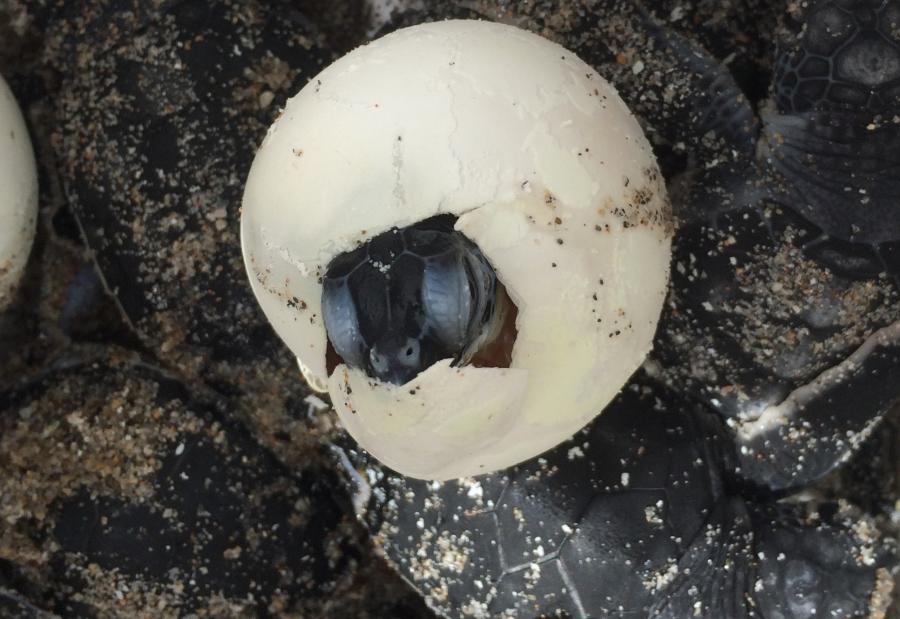News
19.08.2024
Local climate determines size of sea turtle hatchlings
International team headed by the Senckenberg Centre for Human Evolution and Palaeoenvironment at the University of Tübingen gathers data on the endangered animals’ development
Baby sea turtles respond even more to fluctuating precipitation than to changes in air temperature during their development in the egg. The effects of precipitation differ depending on the species – or even the population. In this study, researchers found that rainfall outweighs the total impact of a rise in temperature since it cools the surface of the beach and increases the availability of water needed for development inside the egg, making precipitation a better predictor of body size than ambient temperature, although hatchlings of loggerhead and green turtles respond differently: If loggerhead turtle nests are subject to heavier than average rainfall, the hatchlings will not grow to their usual size, although they will reach a greater weight. Heavy rainfall will not affect the body mass of young green turtles, but the carapace will be larger.
These complex results arose from a comprehensive investigation using data on both species from 37 beaches worldwide, a longitudinal study on beaches in Florida, as well as experiments on the Cape Verde Islands. The investigation was headed by Dr. Omar Rafael Regalado Fernández and PD Dr. Ingmar Werneburg from the Senckenberg Centre for Human Evolution and Palaeoenvironment at the University of Tübingen. The results, obtained in collaboration with the Florida Atlantic University and Berlin’s Humboldt University, can be incorporated into ongoing schemes to protect sea turtles and help in discussions about the impact of global warming. The study has been published in BMC Ecology and Evolution.
Endangered species
Female sea turtles dig a nest, deposit their eggs, then shovel sand over them using their hind legs before returning to the ocean. The sun “incubates” the eggs. After several weeks the small turtles are fully developed and extricate themselves from the egg, then take the fastest route to the sea. “The incubation period and especially their migration over land hold the greatest risks for the offspring. There are many different predators. Large, strong sea turtle hatchlings usually have better chances of survival,” reports Werneburg. It is thought that only one in a thousand hatchlings reaches adulthood. Both of the species investigated in the study – loggerhead sea turtles and green turtles – are seen as endangered worldwide.
The influence of air and sand temperatures on the body growth of sea turtle hatchlings in the egg has been studied many times. “We wanted to add data on the influence of fluctuating precipitation on the offspring during the incubation period,” explains Regalado Fernández. Too much moisture can be fatal for the embryos. Heavy downpours, tropical storms and floods destroy a significant number of nests, as does the removal of sand from the beach. On top of this are the many predators.
Rapid development as a strategy for survival
For their survival strategy, sea turtles rely on the fastest possible development so that hatchlings can reach the sea, their true element, as rapidly as possible in their most vulnerable stage of life. “Until now it was thought that high temperatures in the nest promoted faster development of the embryos,” says Regalado Fernández. “In addition, computer-generated climate models were barely able to forecast precipitation rates with rising air temperatures,” says Werneburg. The researchers now assume, however, that the local climate conditions, and above all the moisture in the ground, have a far greater influence on the breeding success of sea turtles than the global climate, which is hard to quantify.
“To protect the loggerhead and green turtles successfully we still need far more data on the influence of regional weather on incubation and the development of populations. And the data must be available to all those involved in the protection of sea turtles,” says Regalado Fernández.
Publication:
Omar Rafael Regalado Fernández, Parima Parsi-Pour, John A. Nyakatura, Jeannette Wyneken, Ingmar Werneburg: Correlations between local geoclimatic variables and hatchling body size in the sea turtles Caretta caretta and Chelonia mydas. BMC Ecology and Evolution, https://doi.org/10.1186/s12862-024-02290-7
Contact:
Dr. Omar Rafael Regalado Fernández
Museum Exhibition Office
Senckenberg Nature Museum
omar-rafael.regalado-fernandezspam prevention@senckenberg.de
PD Dr. Ingmar Werneburg
University of Tübingen
Department of Geosciences
Senckenberg Centre for Human Evolution and Palaeoenvironment
ingmar.werneburgspam prevention@senckenberg.de
Contact for press:
Eberhard Karls Universität Tübingen
Public Relations Department
Oliver Häußler
Temporary Director
Janna Eberhardt
Research Reporter
Telefon +49 7071 29-77853
Fax +49 7071 29-5566
janna.eberhardtspam prevention@uni-tuebingen.de
All press releases by the University of Tübingen

